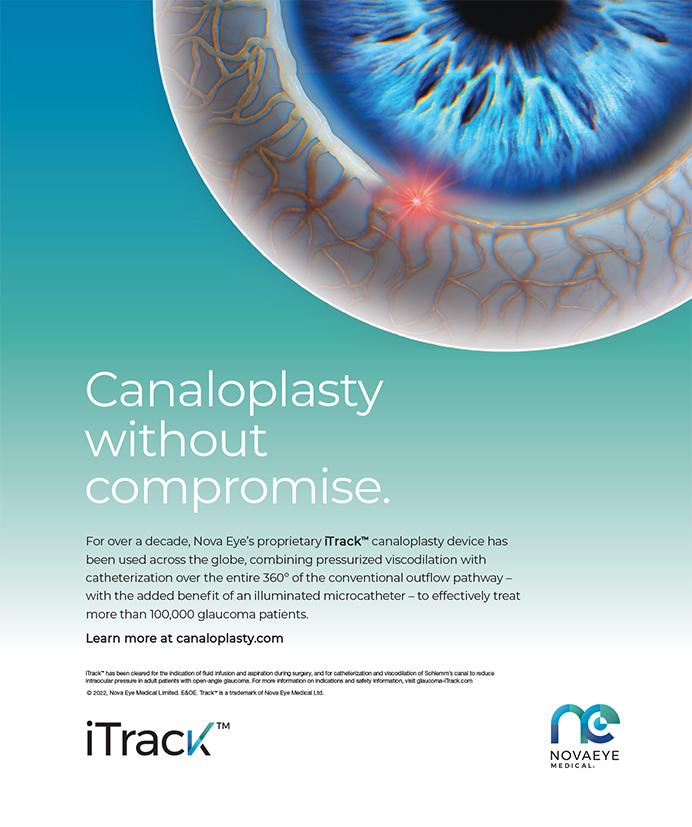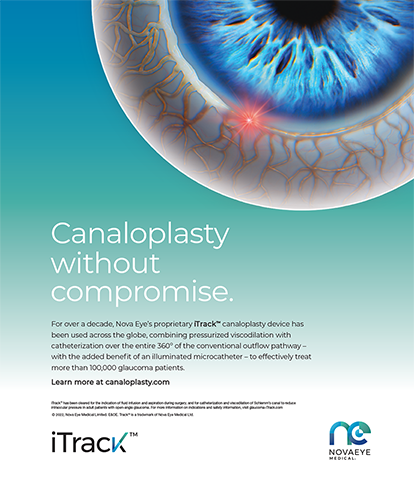Although the Avantix technology (Bausch & Lomb, San Dimas, CA) shares similar facets with ultrasonic phacoemulsification in the sense that it emulsifies material at the tip of a probe, surgeons must learn the subtleties of the actual Avantix method in order to optimize both its efficiency and safety. In transitioning to this technology, surgeons must learn to resist the urge to perform surgery as with traditional ultrasound, in which they must sculpt, chop, and manipulate nuclear material. With Avantix, the key is using surgical skill to maintain the tip in a controlled, stable, and relatively stationary fashion, and to allow the system's impeller and vortex technology to do the work. If necessary, surgeons only need to rotate the probe slightly axially to the right or left to induce material to move.
With Avantix, surgeons must learn how to vary the impeller speed and become familiar with the construction of the tip, in regard to where the irrigation ports are located. The location of the aspiration ports is important for the surgeon to be aware of, so that he or she knows where to place the probe and how to maintain its position in the capsulorhexis (See figures from pages 26 and 27). For example, if the surgeon pulls the probe out of the capsulorhexis, it will induce aspiration without infusion inflow, and the capsule will collapse on the impeller (Figure 1). This is no different from ultrasonic phacoemulsification, in which surgeons have to be cautious on the backstroke of an ultrasonic pass to ensure that the irrigation ports of their ultrasonic sleeve are not pulled into the clear corneal incision, which would produce the same effect, resulting in the collapse of the anterior chamber. Therefore, proper education will facilitate a smooth transition to the Avantix technology.
THE TECHNIQUEStep 1: Creating the Capsulorhexis
The surgeon begins by making a small 1-mm incision for the probe, through which he or she inflates the anterior chamber with viscoelastic. It is important not to overinflate the anterior chamber with viscoelastic, so as not to raise the IOP too high, but to inflate it enough to maintain the space as fluid inflow and outflow occurs endocapsularly (necessary in a true endocapsular procedure). Once the anterior chamber is inflated, the surgeon creates the capsulorhexis as a one-step procedure using an electrocautery unit with a circular disk at its end. The surgeon depresses a foot pedal, and presses the electrocautery probe in and out of the incision, creating a perfect 1-mm round capsulorhexis within a few seconds. The surgeon then very gently aspirates the protein residue from around this wound.
Step 2: Hydrodissection and Emulsification
The next step involves hydrodissecting the nucleus through the 1-mm capsulorhexis. A number of cannulas are being designed especially for this task; I have designed an instrument called the Seibel Avantix Hydrodissection Cannula. The surgeon places the cannula gently over the opening so that the fluid being injected in through the capsulorhexis, as it dissects between the capsule and the cortex, simultaneously has a path of egress so that it minimizes the chance of overinflating the intracapsular contents. The surgeon then introduces the Avantix probe, with its impeller in a retracted position, through the incision and the capsulorhexis opening. Next, the surgeon presses the pedal to engage pressurization or irrigation inflow, which further helps to create a space for the impeller, and then he or she extends the impeller and begins to rotate it. During a procedure, the surgeon can vary the rotational speed of the impeller, which is anywhere from zero up to 100,000 rpm. The surgeon can also slightly vary the axial rotation of the instrument, although within a very small range of ± 20.&Mac251; It is important to stay within these very confined parameters to ensure the efficiency of the procedure as well as to maximize the safety profile (Figure 2). The probe is held relatively stationary while respecting the position of the white marks on the translucent brown sleeve. These indicate the position of the irrigation ports in both the impeller's extended and retracted positions (Figures 1, 3, and 4).
Step 3: Implanting the Lens
As the procedure concludes, the surgeon is left with a clear, empty capsular bag and a small, eccentric 1-mm capsulorhexis that is located slightly to one side. For current lens technology, the surgeon must open the capsulorhexis into a standard size. Keeping in mind that there is still viscoelastic in the anterior chamber, the surgeon injects viscoelastic intracapsularly as well, to form a pseudonucleus that will inflate the capsular bag as a normal lens would, enabling a capsulorhexis with relatively routine techniques. The surgeon simply makes two relaxing incisions, one to make the tear in the desired direction, and another to define a new radius for the tear. Regardless of the location of the capsulorhexis, the surgeon makes one cut to the optical center and then another at a slight angle, and then tears that around in a circle as in a normal capsulorhexis. The viscoelastic that supports the bag permits the use of relatively routine techniques. At that point, the surgeon implants the lens as he or she normally would.
VERSATILITY AND CLEAR CAPSULES
Avantix has been used in a variety of nuclear densities, both in porcine eyes as well as in human cadaver lenses suspended in gelatin, and it performs quite effectively in both situations. The average emulsification time is approximately 1 or 2 minutes, and once the emulsification is finished, the capsules are crystal-clear. Evidently, this is due to a polishing effect by the residual lens material before it is completely aspirated; as it is suspended in the vortex and spinning inside the capsule, it polishes the capsule cleaner and more completely than I've seen achieved by traditional methods.
All illustrations by Barry Seibel, MD, © 2002. To learn more about Avantix technology, please refer to page 26.


